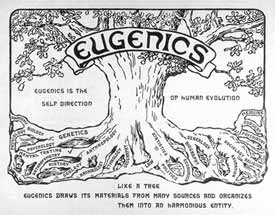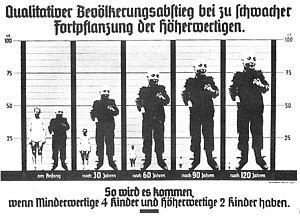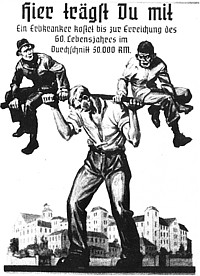| 1.
International Connections: The United States (back
to top)
The Eugenics Movement
- Eugenics: (Greek: 'good origin')
 :
improvement of offspring (reference.com
entry) :
improvement of offspring (reference.com
entry)
- 1863: modern movement started by Darwin's cousin Francis Galton
- Gregor Mendel (1822-1884): theory of genetics (1865) made
a science possible
- 1902: Stanford Univeristy president David Starr Jordan (1851-1931)
published: The Blood of the Nation: A Study of the Decay of
Races through Survival of the Unfit (Boston, American Unitarian
Association, 1902, 1906, 1910), 82 pages
- 1904: Carnegie Insitute-funded research institute on Long Island
(Cold Spring Harbor)
- 1907: first eugenic (forced sterilization) law in the US (Indiana)
- 1909: California was the third state to pass a forced sterilization
law (35 states by 1936)
- 1916: Madison Grant (1865-1937), The Passing of the Great
Race: or, The Racial Basis of European History (New York: Scribner,
1916, 1918, 1919, 1921, 1922 [1970, 2002]), 476 pages; UCSB: GN575
.G75 1916 and 1921.
- 1918: textbook by Paul Popenoe and Roswell Hill Johnson, Applied
Eugenics
(New York: Macmillan, 1918, 1922, 1925, 1933), 459 pages, UCSB:
HQ751 .P6.
- Popenoe was an Army venereal disease specialist in California
- In many ways California led the US eugenics movement
- 1927: Supreme Court affirmed Virginia's law in Buck vs. Bell (Carrie
Buck was sterilized because of sexual promiscuity"--she had
been raped by a relative of her foster parents). In the majority
opinion Justice Oliver Wendell Holmes wrote: "It is better
for all the world, if instead of waiting to execute degenerate offspring
for crime, or to let them starve for their imbecility, society can
prevent those who are manifestly unfit from continuing their kind….
Three generations of imbeciles are enough."
(see the University
of Virginia library's excellent Buck vs. Bell website)
- 1931: publication in English of popular German textbook drawing
on US sources: Erwin Baur, Eugene Fischer, and Fritz Lenz, Human
Heredity, translated by Eden & Cedar Paul (New York: Macmillan,
1931), 734 pages, 172 illustrations. UCI: QH431 .B413
- References:
- Edwin Black, "The
Horrifying American Roots of Nazi Eugenics," Nov. 24,
2003 article published on the History News Network
Black is author of: The War Against the Weak: Eugenics
and America's Campaign to Create a Master Race (2003) (searchable
on amazon)
- Stefan Kuhl, The Nazi Connection: Eugenics, American Racism,
and German National Socialism (Oxford, 1994, 2002) (searchable
on amazon)
- Martin Pernick, The Black Stork: Eugenics and the Death
of "Defective" Babies in American Medicine and Motion
Pictures Since 1915 (Oxford, 1999) (searchable
on amazon)
- Race and Membership in American History: The Eugenics
Movement (Brookline, Mass: Facing History and Ourselves,
2002), 356 pages. UCSB: HQ751 .R33 2002
- Eugenics soon moved to encompass not only "positive"
selective breeding, but "negative" selective weeding out
of people deemed inferior--termed euthanasia.
Black writes in the Nov. 2003 article cited above:
'The grand plan
was to literally wipe away the reproductive capability of those
deemed weak and inferior--the so-called "unfit." The eugenicists
hoped to neutralize the viability of 10 percent of the population
at a sweep, until none were left except themselves.
Eighteen solutions were explored in a Carnegie-supported 1911 "Preliminary
Report of the Committee of the Eugenic Section of the American Breeder's
Association to Study and to Report on the Best Practical Means for
Cutting Off the Defective Germ-Plasm in the Human Population."
Point eight was euthanasia.'
- Euthanasia (Greek: 'good death'): first recorded
in English in 1869 (see reference.com
entry)
- killing the painfully, incurably ill
- Nazi redefinition: killing the racially unfit
- Aktion T4: Nazi code name for program to murder the
disabled
- abbreviation for Tiergartenstrasse 4 (address of Reich Health
Office in Berlin)
- General use of euphemisms and code words, e.g.
- life unworthy of life (lebensunwertes Leben)
- special treatment (Sonderbehandlung)
- resettlement (Umsiedlung, Aussiedlung
|

 Most
historians have attempted to account for the horrible excesses of Nazi
science in one of two ways: as perverted by politicians,
or as perverted by scientists. I think that each of
these accounts is at best narrow, at worst deeply flawed. Both lead
us away from a proper understanding of Nazi medicine—as an important
expression of Nazi social structure and culture."
Most
historians have attempted to account for the horrible excesses of Nazi
science in one of two ways: as perverted by politicians,
or as perverted by scientists. I think that each of
these accounts is at best narrow, at worst deeply flawed. Both lead
us away from a proper understanding of Nazi medicine—as an important
expression of Nazi social structure and culture."

 Ich
klage an); prize-winning feature film with famous actors, 18
million viewers. Pianist has multiple sclerosis, given poison by
husband.
Ich
klage an); prize-winning feature film with famous actors, 18
million viewers. Pianist has multiple sclerosis, given poison by
husband.